#Prypyat
Photo
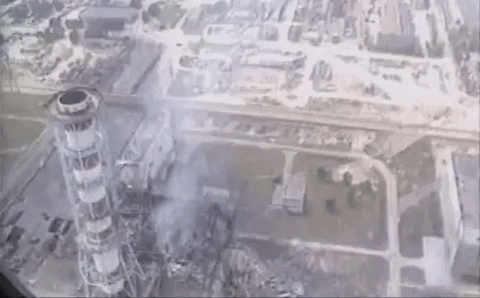



#Chernobyl#Helicopter crashes#crash#helicopter#acidente#nuclear power plant#Prypyat#Pryp’yat#nuclear accidents#radiative#liquidator#my gifs#my gif#gif#my edit
219 notes
·
View notes
Text
fuck winter and fuck this climate as years go i didn't accept it but accepted my right to hate it. because it's truly horrendous here. also my neighborhood sucks. when i stayed at parents i felt like i moved from prypyat like wdym u have streetlights... a post office and two postal box thingies... like 5 grocery stores and 3 pharmacies. meanwhile i have to crawl into society by the same boring annoying road for 20 mins to the same ugly grocery store. same post office and pharmacy too. im going crazy when i can't switch up my route btw. this is all to yet again say fuck my therapist for not getting it
4 notes
·
View notes
Text
I think it's hilarious that the highlight of my trip to Chornobyl and Prypyat was the night when we were getting back to Kharkiv with a stop in Kyiv and since we didn't have kfc in Kharkiv back then I considered it absolutely necessary to visit one in Kyiv (I'd never been to one before that) and dragged a guy I met on the train with me for company then proceeded to order and consume a whole bucket of spicy chicken in one go, immediately felt sick and got a stomachache but still had like three hours untill train departure which I spent crawling about the station alone with local 24/7 coffee shop baristas and vokzal romani looking at me like that 👁️👁️, searching for WC, and then begging my platzkart neighbor to switch places because I could not for the love of god get on the top bunk. Bless his heart for agreeing. I think it's hilarious that my grandma spent a week worrying about me getting radiation poisoning, and I got KOd by kfc chicken.
#I fucking love trips and I love traveling when it's not because of war#10/10 would go again#feral ukrainian
5 notes
·
View notes
Text
Abstract
The genetic diversity of the marsh frog Pelophylax ridibundus populations and the hemiclonal structure of the hybrid form Pelophylax esculentus-ridibundus within the drainages of Prypyat, Dniester, and Southern Bug rivers were analyzed. The absence of a single evolutionary scenario for this hybrid form within the borders of the region has been revealed. The conservation of the basic level of parental species’ evolutionary potential and the interpopulation differentiation of the hybrid form within the drainages of Dniester and Southern Bug rivers was demonstrated. At the same time, in the populations of P. esculentus-ridibundus from the Prypyat basin, a loss of evolutionary potential was revealed (by 31% in the southern part, by 69% in the northern part). It was revealed that the reason for this was the tendency to the extinction of rare haplotypes and the expansion of the mass ones. It was also demonstrated that there was a significant increase (nine to ten times) in the interpopulation differentiation of the hybrid form from the Prypyat River drainage compared with sympatric populations of the parental species P. ridibundus. It was shown that the evolutionary potential loss of the hybrid form P. esculentus-ridibundus accelerated in the absence of parental species, which confirms the hypothesis about regular hybridization as an effective mechanism to compensate for the loss of evolutionary potential.
1 note
·
View note
Photo

Hauschka’s “Abandoned City”
#art#music#hauschka#abandoned city#abandoned places#urbexmusic#urbexsupreme#prypyat#thames town#elisabeth bay#sound#cover#album cover
11 notes
·
View notes
Text

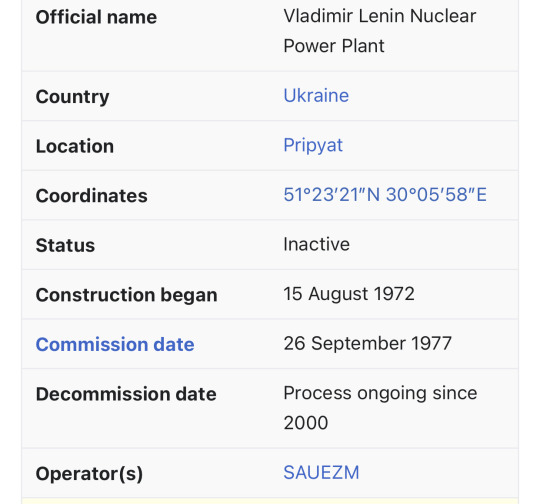
I found out today! That Chernobyl’s commission date was the 26th of September 1977!
Thats my birthday! ❤️
1 note
·
View note
Note
What Pokemon can I find in exclusion zones like Fukushima, prypyat, and 3 mile island? I heard radiation affects Pokemon differently from other living creatures. It's even said to attract the elusive Pokemon, Eaternatus.
Surprisingly enough, despite (or due to) having very few people, many exclusion zones have become havens for wild Pokemon. In fact, in many cases, the number of wild Pokemon has increased since before the disasters. In Prypyat, for example, Deerling and Teddiursa are common sights, and many Noctowl make their nests on the roofs and ledges of abandoned buildings. Unfortunately, however, these Pokemon often suffer from uncommon problems due to their constant exposure to dangerous levels of radiation, though dramatic mutations are rare.
As for Eternatus, exclusion zones tend to be the area where they’re most commonly spotted. However, even there they tend to be rare - and most people don’t stick around for long once they spot it. There are some “Eternatus hunters” out there, though.
13 notes
·
View notes
Photo





Chernobyl Exclusion Zone’s information map for "Orte der Geschichte e.V." showing the special sites within the restricted zone - the nuclear power plant, the ghost town of Prypyat and the DUGAradar among others - as well as information about the catastrophe itself and details about the current visiting possibilities.
It's 35 years since the explosion of reactor no. 4 at the Chernobyl nuclear power plant, in what was to become the biggest nuclear tragedy in history.
The large area surrounding the plant was considered a restricted zone until 2011.
Since then it can be visited on defined and controlled routes with tourists.
- Purchase the map
- Check the available tours
1 note
·
View note
Note
STALKER (any part), Gothic 3, Prince of Persia: The Two Thrones, Anno 2077, Mortal Kombat IX
Es Tee Ay El Kay Ee Ar: call of shadow prypyat of something:
never played | want to play | terrible | boring | okay | good | great | a favorite
I first played one of them as an adult, this jank does not hold up
Gothic 3 as a kid:
never played | want to play | terrible | boring | okay | good | great | a favorite
Gothic 3 as a person that comprehands
never played | want to play | terrible | boring | okay | good | great | a favorite
Prince of Persia: The Two Thrones:
never played | want to play | terrible | boring | okay | good | great | a favorite
I only played Sands of time, liked that one
Anno 2077: never played | want to play | terrible | boring | okay | good | great | a favorite
Mortal Kombat 9: never played | want to play | terrible | boring | okay | good | great | a favorite
2 notes
·
View notes
Photo
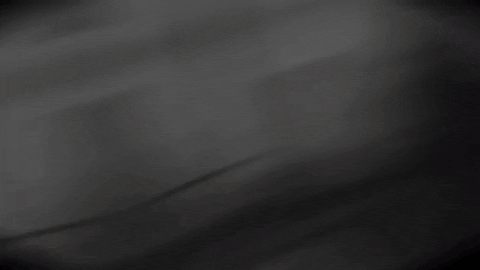
#nuclear power plant#b&w#chernobyl#video#gif#my edit#my gif#urbex#abandoned places#abandoned#places#place#ukraine#Prypyat#Pripyat#При́п'ять#Pryp’yat
143 notes
·
View notes
Photo

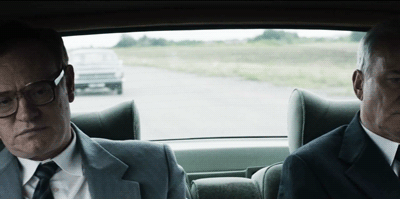







buses. trucks. fire engines.
#and again with dividing the team in actual important parts #so we had Valoris ‘vs’ Ulana and the heart/mind choice #after that a deleted scene in Shcherbina’ apartment like Shcherbina’s suite at the Prypyat hotel #Ulana goes to Valery making THE statement, she’s not there to be the bad character who wants the other to sacrifice himself bc he can but to actually save their work #it’s not about shouting to Gorbachev and the KGB that you will make your voice heard #but stating facts, the ones she found bc he told her and he knew she would’ve #and then this scene where Ulana is cutted out - I don’t even know if you’re supposed to think that she’s in the same car either #and Ulana will feel that Legasov changed his mind after his talk with Boris #she knew ‘cause he went directly to his heart #the bullet #the fear became the superpower #12th doctor vibe #and well yes Dyatlov is part of the game
19 notes
·
View notes
Text
Das Lügengebäude einer Katastrophe

Die fünfteilige Mini-Serie »Chernobyl« von »Breaking Bad«-Regisseur Johan Renck blickt hinter die Kulissen des Atomunfalls von 1986. Angesichts der aktuellen Covid-19-Krise und des vermeintlich reibungslosen Zusammenspiels von Politik und Wissenschaft kann man in der Serie ein unbeabsichtigtes cineastisches Korrektiv für Optimisten sehen.
Grünlicher Staub rieselt von der Decke des Kontrollzentrums, als in der Nacht vom 26. April 1986 Reaktor Nummer 4 im Kernkraftwerk Wladimir I. Lenin explodiert ist. Stille herrscht, in Märchen würde man wohl von schockschwerer Not sprechen. Das bedrohliche Sägen eines Cellos legt sich über die Bilder, die Apokalypse kündigt sich an. Die filmische Aufarbeitung des Unfalls im Atomkraftwerk Chernobyl von »Breaking Bad«-Macher Johan Renck wird ganz bewusst als Endzeit-Erzählung gehalten, denn tatsächlich stand die Welt 1986 mehrmals am Rand eines Untergangs. Der Unfall von Chernobyl ist bis heute die größte vom Menschen verursachte Katastrophe, sofern man den Klimawandel nicht als zusammenhängendes Ereignis interpretiert.
Johan Renck erzählt in seiner HBO-Serie davon, was in den Tagen, Wochen und Monaten nach dem Reaktorunfall in der Sowjetunion passiert ist. Dabei verbindet er mithilfe der bedrohlichen Klänge von Hildur Guðnadóttirs Cello (die bei Johann Jóhannsson Erfolgsprojekten mit Denis Villeneuve ebenso an Bord war wie zuletzt bei Todd Phillips »Joker«-Verfilmung) klug individuelle Erlebnisse mit der großen politischen Erzählung, indem er die Katastrophe aus der Perspektive verschiedener Figuren erzählt, die entweder in politischer Verantwortung stehen, wissenschaftlich beraten oder zu dem millionenschweren Heer an Menschen gehören, die die Reaktorkatastrophe auf die eine oder andere Art und Weise ausbaden müssen.

Leonid Toptunov (Robert Emms) und Alexandr Akimov (Sam Troughton) im Kontrollzentrum des Atomktraftwerks kurz vor der Explosion des Reaktors
Die überwiegend in Litauen gedrehte Serie hat auf den einschlägigen Review-Datenbanken überwiegend begeistertes Feedback erhalten, in der Filmdatenbank IMDB wird sie derzeit mit 9,4 von 10 Sternen bewertet, bei Rotten Tomatoes mit 96 von 100 Prozent bei den Fachleuten und 98 von 100 Prozent beim Publikum. Das kommt nicht von ungefähr, wenn man im Blick behält, dass es sich um eine fiktional zugespitzte Mini-Serie handelt.
Getragen wir die Erzählung von Stellan Skarsgård als sowjetischem Innenminister Boris Shcherbina, Jared Harris als Valery Legasov, führender Kernphysiker des Landes, sowie Jessie Buckley, die die Ehefrau eines der Feuerwehrmänner, die den brennenden Reaktor löschen sollten, spielt. Sie begleitet das elendige Sterben ihres Mannes Vasily, der innerhalb von wenigen Tagen an den Folgen der ausgesetzten Strahlung im wahrsten Sinne des Wortes krepiert (hier hat vor allem die Maske ganze Arbeit geleistet, die den körperlichen Verfall derjenigen, die der tödlichen Strahlung des Reaktors schutzlos ausgeliefert waren, in schockierender Weise nachvollziehbar macht) und steht danach symbolisch für die Langzeitfolgen der Reaktorkatastrophe.
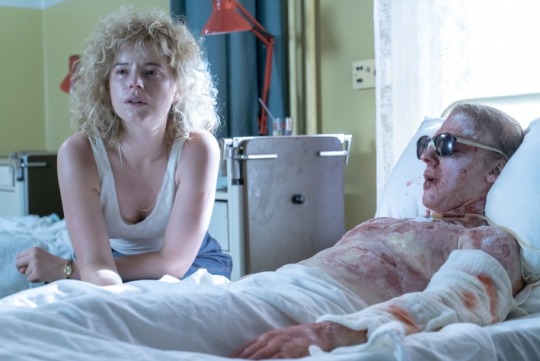
Lyudmilla Ignatenko (Jessie Buckley) begleitet ihren Mann Vasily (Adam Nagaitis) bei seinem grauenvollen Sterben.
Shcherbina und Legasov führen den Kampf gegen die Zeit an vorderster Front, vom Geheimdienst überwacht und ständig mit neuen Herausforderungen und willkürlichen politischen Entscheidungen konfrontiert. Unterstützt werden sie von der Kernphysikerin Ulan Khomyuk (Emily Watson), die in den geheimen Archiven der sowjetischen Wissenschaft recherchiert, um herauszufinden, wie es überhaupt zu der Explosion kommen konnte. Denn dass ein Reaktor überhaupt explodieren kann, wusste nicht nur keiner der Verantwortlichen im Kontrollzentrum, sondern auch sonst niemand. Khomyuk ist von einem guten Dutzend Figuren – Feuerwehrmänner, Wissenschaftler, Bergleute, Militärs, Apparatschiks und einfache Bürger –, die die fünfteilige Serie mit ihren individuellen Geschichten schultern.
Laut Renck beruhen die in seinem Film erzählten Ereignisse vollständig auf verbürgten Tatsachen. Was schon unter normalen Umständen eine starke Aussage bei einem dramatischen Kunstwerk ist, wirkt bei so einem politisch brisanten Vorfall natürlich doppelt. Zumal Aussagen wie »Jede Lüge, die wir erzählen, geht zu lasten der Wahrheit« die Latte der Erwartungen hoch legen. So ist es kein Wunder, dass sich seit Ausstrahlung der Serie (die im vergangenen Jahr auf dem Bezahlsender Sky gezeigt wurde) die Kritik an dieser Behauptung aufhängt. Dem Film wird dramatische Überhöhung, Effekthascherei und Übertreibung der Unfallfolgen unterstellt. Bedenkt man aber, dass es sich hierbei nicht um einen Dokumentarfilm, sondern um eine fiktionale Verarbeitung der Ereignisse handelt, die Höhepunkte und Cliffhanger produzieren muss, dann relativiert sich diese kritische Einschätzung. Zumal Renck den Fokus nicht auf die wissenschaftliche Aufarbeitung der Ereignisse legt, sondern auf die Folgen des Atomunfalls für die einfachen Menschen. Er zeigt, wie eine Katastrophe von jetzt auf gleich jeden treffen kann, unabhängig von der Stellung in der Nomenklatura der Partei, dem Rang, Beruf, Alter und Geschlecht.
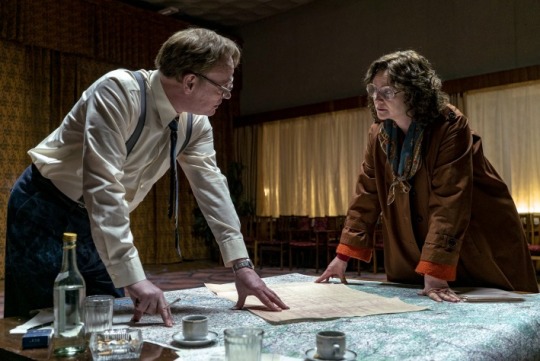
Valery Legasov (Jared Harris) und Ulana Khomyuk (Emily Watson) im wissenschaftlichen Austausch.
Die Serie überzeugt in ihrer erzählerischen Wucht, und das aus zwei Gründen: Zum einen wissen Johan Renck und sein Kameramann Jakob Ihre um die Macht von Bildern. Vor allem in dem besonderen Kontext, als dass sie eine Geschichte erzählen, um deren Bedeutung die Zuschauer wissen, die beteiligten Figuren jedoch nicht. Ob die vor Radioaktivität glimmende Rauchsäule, der auf die schaulustigen Anwohner von Prypyat niedergehende Feinstaub oder der durch die umliegenden Wälder wehende Wind – diese an und für sich symbolischen Aufnahmen haben angesichts der unmittelbaren Bedrohung dieser Katastrophe eine immens starke Wirkung.
Zum anderen ist der aufklärerische Aspekt immens. Craig Mazin ist es mit seinem Drehbuch gelungen, die wissenschaftlichen Fakten in begreifbare Bilder zu übersetzen. Insbesondere der letzte Teil der Serie, der von Valery Legasovs Aussage im Strafprozess gegen Chefingenieur Anatoly Dyatlov (Paul Ritter) getragen wird, werden (dem Format geschuldet natürlich auf Kosten wissenschaftlicher Komplexität) nicht nur die Vorgänge innerhalb eines Kernreaktors verständlich, sondern auch das System der Verheimlichung und Vertuschung wissenschaftlicher Forschung, um das Bild der überlegenen Sowjetunion aufrecht zu erhalten. Das propagandistische Lügengebäude von Chernobyl fällt in »Chernobyl« vor unseren Augen in sich zusammen.

Valery Legasov (Jared Harris) und Boris Shcherbina (Stellan Skarsgård) müssen ihr handeln vor Ort politisch rechtfertigen.
Nicht zuletzt veranschaulicht die Mini-Serie wie kaum eine andere das Verhältnis von Politik und Wissenschaften im Katastrophenfall. Das betrachtet man angesichts der weltweiten Corona-Pandemie natürlich mit einem anderen Auge. Die Expertenrolle von Valery Legasov hat in Deutschland aktuell der Berliner Virologe Christian Drosten inne (wenngleich Drosten seine Funktion als Experte in einer demokratischen Gesellschaft deutlich offensiver nach außen tragen kann), die von Boris Shcherbina könnte grob formuliert die von Jens Spahn sein. Anhand des Verhältnisses von Shcherbina und Legasov kann man nun beobachten, was es heißt, wissenschaftliche Erkenntnisse in politische Aussagen zu übersetzen. Kompromiss und die Wahl des zweckmäßigsten Mittels – insbesondere bei fehlenden Alternativen – sind hier die Zauberworte.
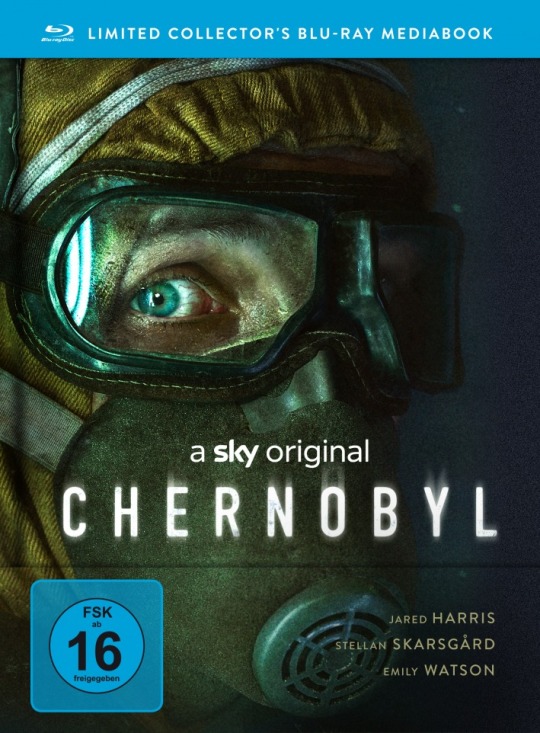
Johan Renck: Chernobyl. Mit Jared Harris, Stellan Skarsgård, Emily Watson, Paul Ritter, Jessie Buckley. Polyband Medien 2019. 312 Minuten. 12,99 Euro (DVDV). 19,99 (Blu-ray)
Zudem wird deutlich, dass Wissenschaft – vor allem im Katastrophenfall – nur durch nüchterne Analyse und Kooperation funktioniert. Man kann nur hoffen, dass Drosten – dem die ihm medial unterstellte Heilsbringer-Funktion selbst unangenehm ist – aus seinem fachlichen Umfeld ähnliche Unterstützung erreicht wie Legasov während seines Einsatzes in Chernobyl. Ulana Khomyuk repräsentiert als fiktive Symbolfigur zahlreiche Wissenschaftler, die Legasov nach dem Reaktorunfall berieten. Hätten die ihre Ableitungen und Erkenntnisse in den Tagen und Wochen der Katastrophe nicht geteilt, wären die Ausmaße und Folgen der Reaktorkatastrophe in Chernobyl noch einmal völlig andere gewesen. Menschen wir diesen Wiwssenschaftlern, aber auch den unzähligen namenlosen Personen, die sich – wissend und unwissend – unmittelbar oder auf lange Sicht geopfert haben, setzt dieser Film ein Denkmal.

Ausgabe 44 des Film- und Medienmagazins CARGO enthält ein umfangreiches Gespräch von Christian Petzold und Simon Rothöhler über »Chernobyl«.
Was ist der Preis der Wahrheit? Diese Frage steht am Anfang von Rencks Serie, die damit beginnt, wie Valery Legasov seine Beobachtungen und Erkenntnisse der Ereignisse in Chernobyl auf Tonbänder spricht. Am Ende seiner Aufnahmen, die in der Sowjetunion unter Wissenschaftlern kursierten, fragt er nicht mehr nach dem Preis der Wahrheit, sondern dem der Lüge. »Jede Lüge, die wir erzählen, geht zu Lasten der Wahrheit. Doch die Wahrheit verschwindet deshalb nicht. Der Wahrheit ist egal, was wir wollen oder brauchen. Sie wird für alle Zeiten auf uns lauern«, hört man ihn am Ende von den Bändern sprechen. Johan Rencks »Chernobyl« bringt uns der Wahrheit von Chernobyl ein ziemliches Stück näher.
Read the full article
#ChristianDrosten#CraigMazin#DenisVilleneuve#EmilyWatson#featured#HildurGuðnadóttir#JakobIhre#JaredHarris#JensSpahn#JessieBuckley#JóhanJóhannsson#JohanRenck#PaulRitter#StellanSkarsgård#ToddPhillips
1 note
·
View note
Text
CNN.com: Chernobyl to become official tourist attraction, Ukraine says.
https://www-cnn-com.cdn.ampproject.org/c/s/www.cnn.com/travel/amp/chernobyl-tourist-attraction-intl-scli/index.html
0 notes
Text
Todo lo que estaría bien saber antes de tu visita a Chernobyl.
Todo lo que estaría bien saber antes de tu visita a Chernobyl.
Crónica de una moda anunciada.
A la altura del tercer capítulo de la serie Chernobyl que podéis ver en HBO, basada en el mayor desastre nuclear de la Historia, las redes y foros empezaron a arder. Todo el mundo hablaba ya de la mejor serie del año, mejor incluso que Juego de Tronos a la que ha destronado en puntuación en tan sólo meses. Desde ese momento supe que mis amigos fotógrafos, tan…
View On WordPress
0 notes
Photo
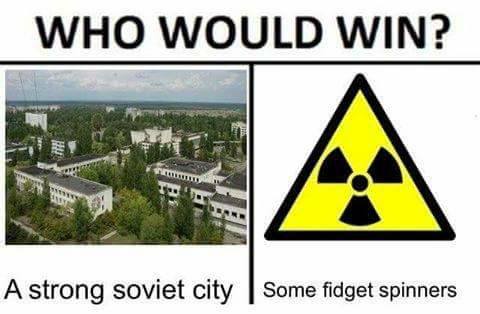
I like new Mortal Kombats characters.
0 notes
